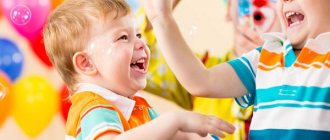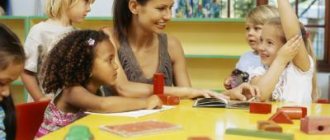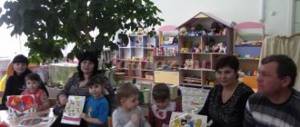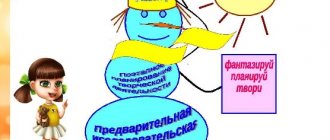Final parent meeting in the second junior group “What have we learned in a year”
9.One is many
When playing to determine the number of objects in the initial version, it is better to use a combination of the concepts “one - many”: one pencil - many pencils, one fork - many forks.
10.Choose a word
The child is asked to select words for any object or object that denote its characteristics and qualities. For example, what is winter like? (cold, snowy, frosty.) What kind of snow (White, fluffy, soft, clean, sticky.)
11.Who can do what?
The child is asked to select as many action words as possible for the subject or object. for example, what can a cat do? (purr, arch your back, scratch, jump, run, sleep, play).
12.Say the opposite
The adult names a word, and the child selects the “word opposite”. Nouns: laughter-..., summer-..., day-..., cold-..., north-... etc. Verbs: came-..., dived-... Adjectives: wide-..., small-..., rich-... etc. Adverbs: far-..., high-...
Games outside, in nature.
1.With pebbles
(type large and small separately; draw a figure and ask to lay it out with pebbles; count;
2.Learning colors.
"Traffic Light" is an elementary game. The presenter (mother) names the color, and the child must touch the object or show an object of that color.
3. We draw with crayons.
It is very interesting to draw on the street, and even with crayons. If you want active games, play hopscotch; if you want logical games, draw an object without details. Ask your child – what is missing? You can study geometric shapes right on the asphalt. We draw circles with crayons - these are beads for mom, and a funny bun, and an apple that fell from a tree.
Play and talk on the way to kindergarten, to the store, to visit.
At this age, children are very inquisitive; for them now the world around them is one big laboratory for research. Please do not suppress this curiosity, ask and answer.
You often hear mothers complaining about their babies, that children climb everywhere, that they don’t know the word “no”, open cabinets, climb on the table, open drawers, take everything out...etc.
A little more time will pass, and the child will sit down at the computer. And mothers will start complaining again... “the child doesn’t want to do anything, he doesn’t care about anything, he’s not interested in anything, he sits at the computer all day, and there’s so much interesting stuff around.” And they don’t suspect that they themselves led to this by prohibiting and punishing curiosity.
An active process of cognition is going on in the head of a small child; he does not know or understand many things happening in this world. He has a great desire to learn about everything, and during this period you should become a source of knowledge and information for your child, you have a lot of life experience behind you, become for your child not only a parent, but also a teacher, a professor who knows about everything in the world .
Parent meeting in the second junior group “So we have become more mature.”
We need to go through all this and we (adults) need to behave correctly at this time.
The separation of a child from home, from relatives, from familiar conditions is severe stress. After all, the baby accepts this situation as a deprivation of parental love, protection and attention. Therefore, it is very important to make a smooth transition from
families in kindergarten.
The first days or even weeks can be difficult - the child may refuse “kindergarten” food, sleep poorly during the day, be very tired, cry a lot, look lethargic and depressed... The natural feelings of any mother are pity, compassion and, perhaps, even a feeling of guilt for the harm caused suffering.
A mother's heart breaks at the sound of a child's desperate cry. Especially when this cry accompanies her every morning for several weeks and sounds in her memory all day long. You have to go through this if you really need a kindergarten, otherwise you shouldn’t start! When you leave, leave. Don’t poison your soul by watching the site from behind the fence or listening under the door.
By the way, children most often quickly calm down immediately after their mother disappears from sight.
Introduce your child to kindergarten gradually. At first, you will only have to leave your child in the kindergarten for a few hours. You will pick it up before lunch. Gradually this interval will increase. Then you can leave the baby for lunch and pick him up before bedtime. And so gradually, if no complications arise, after 1-2 weeks you can switch to the normal regimen.
Try to bring your home regime closer to the gardener's and follow it even on weekends.
Wise fathers and mothers!
The adaptation period is not the easiest in your life and the life of your baby.
You will probably worry, and he will probably miss his mother. With time everything will get better. And it is in your power to make sure that your baby’s first path is not too bumpy.
The period of adaptation coincides with a crisis of personality development, which can be described as “I’m on my own!” The child begins to become aware of his own “I”. He strives for independence and self-affirmation. At this time, his will and self-esteem are actively developing, which is manifested in the desire to set goals and achieve them at any cost, and is also proud of his achievements. All these new features are a positive consequence of the crisis for the child.
However, the 3-year crisis also has an unpleasant side - the aggravation of parent-child relationships. All of a sudden, the baby develops some characteristics that are very worrying for moms and dads: despotism, self-will, stubbornness, obstinacy and negativism. They are found in the fact that the child strives to achieve from his parents exactly what he wants, even if it brings him harm. The child does not value the opinion of adults, refuses to obey demands and requests, trying to do the opposite. It is worth noting that children usually endure a crisis more difficult than their parents. The child himself does not understand why he behaves this way and does not know how to restrain his impulses and emotions. He refuses to go to bed, does not want to dress himself, or put away his toys. He is capricious, screams and stomps his feet if any of his requests are not fulfilled. It’s not uncommon for a child’s behavior to take parents by surprise.
Summary of the parent meeting in the second junior group
Parent meeting summary
in the second junior group
Topic: “The beginning of the school year is the beginning of a new stage in the life of the kindergarten and its students”
Educator: Gatina G.Sh.
G. Perm
Topic: “The beginning of the school year is the beginning of a new stage in the life of the kindergarten and its students”
Goals: expanding contact between teachers and parents; modeling prospects for interaction for the new academic year; improving the pedagogical culture of parents.
Objectives: consider the age and individual characteristics of children 3-4 years old; introduce parents to the tasks and features of educational work, the tasks of the preschool institution for the new school year; update the personal data of the families of the pupils; teach parents to observe the child, study him, see successes and failures, try to help him develop at his own pace; intensify work on children's speech development.
Participants: teacher and parents.
Event plan:
1. Introductory part.
2. Age and individual characteristics of children 3-4 years old.
3. Features of the educational process in the second junior group.
4. Introducing parents to the goals and objectives of the preschool educational institution for the new school year.
5. Elections of the parent committee.
Progress of the event
Preparatory stage.
Preparation of an article about the age and individual characteristics of children 3-4 years old; extracts from the annual work plan of the preschool educational institution for the new academic year.
Organizational stage.
Parents come in and sit down randomly. Music plays to help relieve fatigue and encourage collaboration.
Introductory part.
Solemn music sounds.
Educator: Good afternoon, dear parents! I am very glad to see you in our cozy kindergarten! I would like to congratulate you on the new academic year. Your children have grown up over the summer and moved to the second junior group of kindergarten.
Today we - children, teachers and parents - are setting off on a journey across the ocean of Knowledge, where we will get acquainted with the educational process for the school year.
Educator: And so our ship is ready to sail. Full speed ahead!
Slide 1. “Age characteristics of children 3-4 years old”
Do you, dear parents, know the characteristics of our main travelers? What are children aged 3-4 years like?
Each child develops differently, each has its own path and pace of development. But there is still something in common that allows us to characterize children and their age characteristics. Let’s draw up a general age portrait of a 3-4 year old child, highlighting the indicators of different aspects of his development.
Slide 2 “Features of the educational process in the second group.”
Dear parents, I would like to introduce you to the daily routine in our group and ask you to follow it. ( daily regime). Reception of children until 8.10. This year we have morning exercises in the music room at 8.15, so I ask you to bring your children before 8.00 - 8.10. Then there is breakfast and classes begin. If you are late and arrive during class, wait until class ends in the locker room. This year we will continue to engage in physical education and music, and for this the children need sports uniforms, shoes and Czech shoes.
Slide 3 “Introducing parents to the goals and objectives of the preschool educational institution for the new school year.”
1.Formation of children’s health on the basis of an integrated and systematic
using available means of physical education and optimization
motor activity of children, ensuring the active position of children and
parents in the process of mastering the basics of a healthy lifestyle;
2.Introduction of interactive methods and information and communication technologies in the formation of cognitive and speech development of preschool children.
3. Introduction of new forms of interaction with children and their parents as equal subjects of the educational process in the conditions of the Federal State Educational Standard.
Our kindergarten operates according to the program “From birth to school” edited by N.E. Veraksy, T.S. Komarova, M.A. Vasilyeva.
This school year, the development of children will be carried out through the organization of all types of children's activities: gaming, communication, elementary labor, motor, cognitive-research, visual, constructive, musical, perception of fiction and folklore.
Slide 4 “Schedule of educational activities.”
Organized activities for children are carried out in the following educational areas:
“Socio-communicative development”,
"Cognitive Development"
"Speech development"
"Artistic and aesthetic development"
"Physical development"
Slide 5 “Mnemonics - the art of memorization”
Also, dear parents, our main task is to develop the child’s speech, make it clear, correct, teach them to express their thoughts correctly and easily, so I have developed a plan for additional work with children on the topic
“Speech development using mnemonics in preschool children.” Mnemonics is the art of memorization.” When teaching children coherent speech, you can use mnemonics techniques such as: mnemonic track, mnemonic tables, pictograms, collage and much more.
Slide 6 “Additional educational activities”
Our group will be holding a circle “Visiting Grandma-Zabavushka”, where children will continue to get acquainted with works of oral folk art.
The purpose of the circle is to develop the various abilities of children in the process of getting acquainted with works of oral folk art, to help preschoolers master spoken language, and master their native language.
Slide 7
We also plan to conduct two short-term projects during the academic year:
Project “Autumn, golden autumn”
Project “Speech development using mnemonics in children of primary preschool age”
You can get acquainted with the work of teachers in the second junior group on the teacher’s website
Election of a new parent committee
.
Dear parents, to help organize all our joint events we need to select a parent committee of the group
( 3 persons)
Final part
Our journey to the land of Knowledge does not end, but continues, we are now one team, and our final berth will be “School”; the path is difficult and not easy. Understanding, good relationships, mutual assistance and mutual respect are very important in our team. The conditions for harmonious relationships between children and parents, children and teachers, teachers and parents is the ability to give in to each other, mutual tolerance is the same for all parents. Let us remember I. Krylov’s fable “The Swan, the Crayfish and the Pike”: “When there is no agreement among the comrades, their business will not go well, and what will come out of it is not work, but only torment.” Hence the conclusion that we have to combine our efforts to make children comfortable and interesting in kindergarten. We wish you success, interesting discoveries, fun and interesting days in our kindergarten! Only forward!



